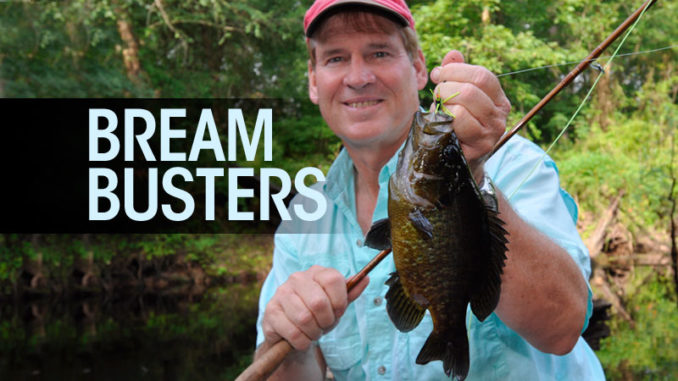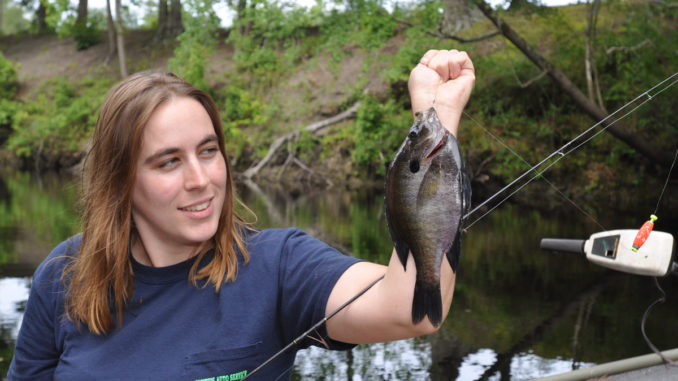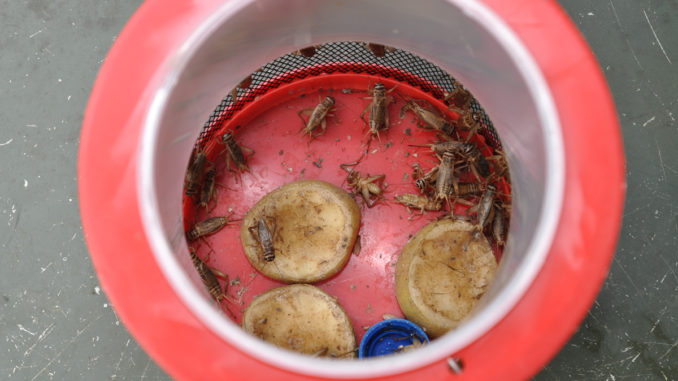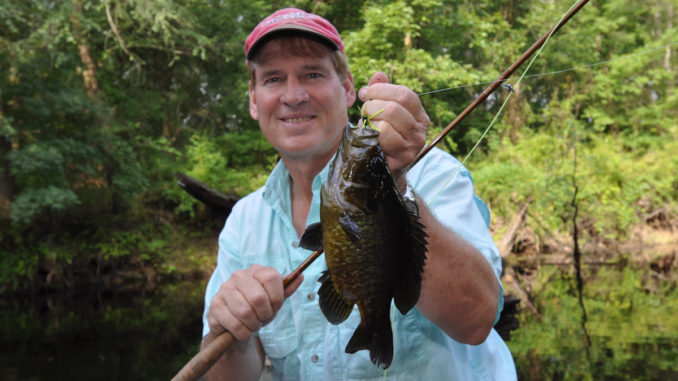
Fishermen working the Northeast Cape Fear River will do plenty of damage on panfish this month.
Webster’s dictionary defines “idyllic” as “charmingly simple or picturesque.” If any place in the world meets that definition, it is the Northeast Cape Fear River. With banks shaded by cypress, gum, oak, hickory and pine trees wearing wigs of Spanish moss that waft in the gentlest breeze, it is one of the one of the most-beautiful blackwater rivers in North Carolina. Some stretches run miles with few boat docks or other signs of human habitation, adding to its draw as a bream-fishing destination.
On a warm, summer morning, Chris Parker and Rhonda Leary of Jacksonville were floating along in a 14-foot john boat, fishing for bream in Holly Shelter Creek near the N.C. Wildlife Resources Commission boat landing of the same name.
“We come here at least every other weekend as long as the weather is nice,” said Parker, who threaded a wriggling worm on a hook, where it dangled beneath a blaze-orange bobber. He cast beside the decaying fingertips of a tree that had toppled from the bank and drowned in the coffee-colored water and watched it intently, waiting for a strike.

Meanwhile, Leary chased a cricket around a wire-mesh cage before corralling it in her palm.
“Chris is using worms, and I am using crickets,” Leary said. “It gives the fish two baits to choose from.”
The crickets chirped while the electric trolling motor hummed. Other than the call of a prothonotary warbler, the only other sound was the plunk of a bobber splashing down.
Parker reached inside the live well and pulled out a pumpkinseed sunfish to show off.
“A pumpkinseed is one of the prettiest fish you can catch,” he said. “We have a bunch of bluegills and a couple of goggle-eyes. We already have 15 fish and haven’t been here long.”
Leary’s bobber wiggled, then it took off for the depths. She set the hook and reeled in a bluegill, estimating its weight at three-quarters of a pound pound.
“We catch a lot of big bluegills. They put up a good fight and are good to eat,” said Leary, who, like Parker, was using an ultralight spinning outfit loaded with 6-pound monofilament that is light enough to allow a fish of any size to put up a good fight.
Parker said the most-important ingredient for a good bluegill trip was arriving early.
“As soon as the sun shines over the treetops, fish stop biting,” he said. “The hotter the weather, the quicker they stop, so you need to get to the ramp at sunrise. The best fishing is on the shady side or in the shadows of a tree. Cast to anything that sticking out of the water, and you might catch a fish.”

Located on Shaw Road in Pender County, the Holly Shelter Creek boating access is one of six that provide access to the Northeast Cape Fear. It is not far from the river itself, which winds through the swamps of Duplin and Pender counties before joining the Cape Fear River in Wilmington. Sawpit Landing, accessible from NC 53, is at the confluence of Holly Shelter Creek and the Northeast Cape Fear and allows direct access to the river. These two ramps are the midpoint of the best fishing.
Head upstream from NC 53 and an angler is more apt to run into sandbars that will block a vessel’s path during periods of low water. Conversely, heading downstream assures water of fishable depth under nearly any conditions. The river is tidal to NC 53 or a bit farther upstream. Anglers can use the tide to their advantage by heading up the feeder creeks as the tide rises. Following the tide downstream to the river guarantees adequate water depth. Fish also bite best during falling tide when baitfish and other prey flush from the swamps.
Upstream of Sawpit Landing, anglers can launch at Wayne’s, Chinquapin and Kenansville boating access areas. Anglers in smaller john boats, wooden boats, kayaks and canoes find good fishing in this shallower stretch.
The Holly Shelter ramp provides access where the river is wider and deeper and bass boats start to supplant john boats. Anglers should check out the feeder creeks in this reach, including Burgaw, Lillington and Harrison’s.

Farther downstream, Island, Turkey, Long and Prince George creeks have lots of bluegills and other sunfish. These creeks are easily accessible from Castle Hayne ramp along NC 133 on the New Hanover side of the river. This area receives heavy boat traffic, with all types of pleasure craft churning the river. The best tactic is to fish the main river early then duck into one of the creeks as the traffic and air temperature heat up.
DESTINATION INFORMATION
HOW TO GET THERE — The Northeast Cape Fear River winds through Duplin and Pender counties before joining the larger Cape Fear River near Wilmington. I-40 provides the best access from most places in North Carolina. Popular boat ramps are Castle Hayne on Orange Street in Castle Hayne, Holly Shelter on Shaw Road near Burgaw, Sawpit off Whitestocking Road near Burgaw, Shelter Creek off Shaw Road in Burgaw, Wayne’s Landing on Cypress Hole Road near Wallace, Chinquapin on Quiet Water Drive in Chinquapin and Kenansville on Wildlife Landing Road near Kenansville.
WHEN TO GO — The best fishing for panfish in the Cape Fear River is in April, May and June.
BEST TECHNIQUES — Fish worms and crickets on float rigs. Beetle-grub spinners, popping bucks and sponge spiders are the most-popular artificials.
FISHING INFO — For river and ramp conditions, call the N.C. Wildlife Resources Commission’s Holly Shelter Wildlife Depot, 910-259-5555.
ACCOMMODATIONS — Sleep Inn, Market Street, Wilmington, 910-313-6665.
MAPS — DeLorme’s North Carolina Atlas and Gazetteer, 800-452-5931, www.delorme.com.

